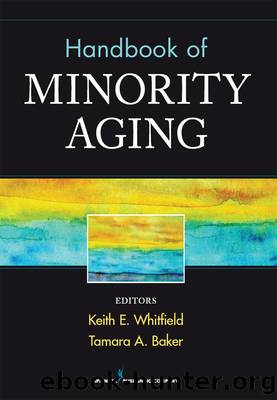Handbook of Minority Aging by Whitfield Keith;Baker Tamara;

Author:Whitfield, Keith;Baker, Tamara;
Language: eng
Format: epub
Publisher: Springer Publishing Company, Incorporated
Cultural Competence Framework
In the United States, the dominant discourse about illness, dying, and death focuses on autonomy, independence, self-control, and individual choice. Our health care system reinforces this autonomous decision making through the legal structures of advance directives. The focus on the individual and on planning for death presupposes the following elements: the individual is the primary decision maker; the individual has an interest in being in charge; typically, there is a clear communication and understanding between the individual and the medical team about diagnosis, prognosis, and options; the individual has equal financial access to the different options offered; and the individual has the power and sense of entitlement to make whatever choice is desired (Field et al., 1997).
There are many people in the United States, particularly minority older adults, for whom at least some of these conditions may be neither attainable nor desirable. In the absence of a cultural competence framework, this model of EOL care may be inadequate because it does not account for the experiences and values of persons who are in one way or another culturally different or socially disadvantaged. This includes ethnic and religious minorities for whom collective decision making may be a priority. Persons who are economically disadvantaged also may not access a range of different EOL care options that do not rely on informal support networks because of the cost of care.
Minority elders vary in regard to their beliefs and opinions about EOL decision making. This includes their views on the appropriateness of talking about and planning for death; truth-telling (Candib, 2002), which may take the form of advising persons that they are dying; and the roles of the collective family members and fictive kin in the decision-making process, as well as communicating with physicians regarding EOL decisions. These groups also may vary in even more basic dimensions (such as orientation to the future, the social construction of the self, and beliefs about who is in control of oneâs destiny and/or fate) that may have implications for EOL decision making (Bullock, 2011). In addition, within-group differences among racial/ethnic minority elders in their social support network and/or extended family system can be as great as, or greater than, between-group differences because individuals are often exposed to multiple and sometimes contradictory systems of values. To this point, it is worth acknowledging that not all Latinos/Hispanics will desire the same EOL care, and neither will all black or African Americans, Asians, nor any other racial/ethnic group members. Group experiences and the system of values affecting attitudes and behavior are not static. Although there are cultural values and norms that are helpful to be aware of and knowledgeable about, culturally appropriate assessments should be conducted to determine the extent to which one identifies with his/her cultural norms and their individual preferences at EOL (NASW, 2004).
Cultural competency practices have been widely accepted in social work as a means to decrease disparities in the quality of services delivered to ethnic minority groups. NASW (2007) Standards for Cultural Competence include
Download
This site does not store any files on its server. We only index and link to content provided by other sites. Please contact the content providers to delete copyright contents if any and email us, we'll remove relevant links or contents immediately.
Human Diseases (MindTap Course List) (by Team-IRA) by Marianne Neighbors Ruth Tannehill-Jones(844)
The Neglected Dimension of Global Security: A Framework to Counter Infectious Disease Crises by National Academy of Medicine Secretariat(421)
Statistical Methods in Health Disparity Research by J. Sunil Rao(399)
Imaging in Urology by Mitchell Tublin MD Joel B Nelson MD(394)
Short Course in Medical Terminology by Nath Judi L.;(331)
Cancer Cell Culture by Unknown(304)
Wilkins' Clinical Practice of the Dental Hygienist by Boyd Linda D.;Mallonee Lisa F.; & Lisa F. Mallonee(301)
Clinical Research in Occupational Therapy, Sixth Edition by Martin Rice;(300)
Murray's Basic Medical Microbiology E-Book by Murray Patrick R.;(282)
Anatomical Kinesiology by Gross Michael;(281)
Psychedelics As Psychiatric Medications by Nutt David;Castle David;(272)
Neuroscience Fundamentals for Rehabilitation by Lundy-Ekman Laurie(271)
Health Behavior: Theory, Research, and Practice by Karen Glanz & Barbara K. Rimer & K. Viswanath(270)
Rang & Dale's Pharmacology 9th Edition plus Flashcards 2nd Edition by Unknown(250)
Achieving Procreation : Childlessness and IVF in Turkey by Merve Demircioğlu Göknar(249)
Public Health and Society: Current Issues by Burke Lillian D.;Weill Barbara;(246)
The Handbook of Medicinal Chemistry by Simon E Ward;Andrew Davis;(245)
Primary Care Occupational Therapy by Unknown(239)
From Good Schools to Great Schools by Susan P. Gray & William A. Streshly(232)
